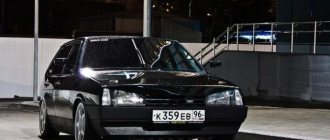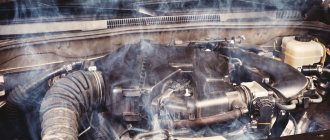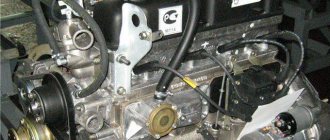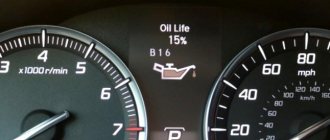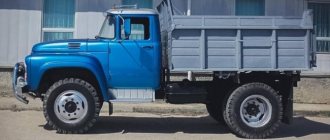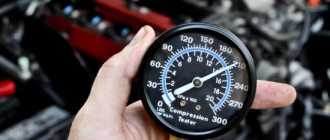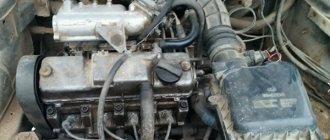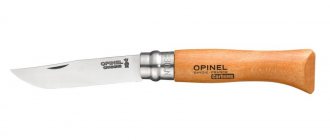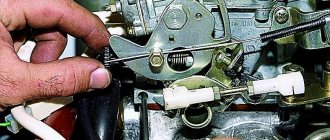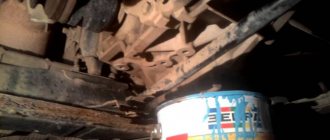1) In-line arrangement of cylinders
Denoted by the symbol R. This is one of the most common types of engines, which is used in both small cars and crossovers. With this arrangement, the cylinders are placed sequentially one after another, while being in the same plane. This is the simplest type of layout, if you take into account the manufacturing process. Most often, in-line engines have four cylinders, but there are cases where six cylinders are used. The in-line engine type has found its application in the sports versions of Renault Megane (pictured) and Renault Clio.
Types and parameters of internal combustion engines
Automotive piston internal combustion engines (ICEs) have many indicators - power, torque, fuel consumption, emissions of harmful substances, etc., which largely depend on their design parameters.
Engine types
An engine is a device that converts the energy of fuel combustion into mechanical work. Almost all car engines operate on a cycle consisting of four strokes:
- intake of air or its mixture with fuel;
- compression of the working mixture,
- working stroke during combustion of the working mixture;
- exhaust gas release.
The most common engines in cars are piston engines - gasoline and diesel engines.
Gasoline engines have forced ignition of the fuel-air mixture with spark plugs. They differ according to the type of power system:
- in carburetor engines, the mixing of gasoline with air begins in the carburetor and continues in the intake manifold. Currently, the production of such engines is declining due to low efficiency and non-compliance with modern environmental standards;
- in injection engines, fuel can be supplied by one injector (nozzle) into a common intake manifold (central, single injection) or by several injectors in front of the intake valves of each cylinder (distributed injection). They may slightly increase maximum power and reduce gasoline consumption and exhaust gas toxicity due to more accurate fuel dosage by the electronic engine control system;
- engines with direct injection of gasoline into the combustion chamber, which is supplied to the cylinder in several portions, which optimizes the combustion process, allows the engine to operate on lean mixtures, and accordingly, fuel consumption and emissions of harmful substances are reduced.
Diesels are engines in which ignition of a mixture of fuel and air occurs from an increase in its temperature during compression. Compared to gasoline engines, these engines have better efficiency (by 15-20%) due to a higher (two or more times) compression ratio (see below), which improves the combustion processes of the fuel-air mixture. The advantage of diesel engines is the absence of a throttle valve, which creates resistance to the movement of air at the intake and increases fuel consumption. Diesel engines develop their maximum torque (see below) at a lower crankshaft speed (in common parlance, “low-torque”).
Diesels of outdated designs had a number of disadvantages compared to gasoline engines:
- greater weight and cost for the same power due to the high compression ratio (1.5-2 times more), which increased the pressure in the cylinders and the load on the parts, which forced the production of more durable engine elements, increasing their dimensions and weight;
- greater noise due to the peculiarities of the fuel combustion process in the cylinders;
- lower maximum crankshaft speeds due to the higher mass of parts, which caused large inertial loads. For the same reason, diesel engines, as a rule, have less throttle response - they pick up speed more slowly.
Rotary piston engine (Wankel) - in it the rotor-piston does not reciprocate, as in gasoline engines and diesel engines, but rotates along a certain trajectory. Thanks to this, it has good throttle response - it quickly picks up speed, providing the car with good acceleration dynamics. Due to design features, the compression ratio is limited, so it only runs on gasoline and has worse efficiency due to the shape of the combustion chamber. Previously, its disadvantage was a smaller resource, and now low environmental performance, which is now receiving great attention.
A hybrid power plant is a combination of a piston engine (usually a diesel engine), an electric motor, a generator and traction batteries (the traction battery, unlike the starter battery, is designed to discharge with high currents (50-100 A) for 30-60 minutes) batteries .
This installation operates in different modes depending on the nature of the vehicle's movement. During intense acceleration, the piston and electric motors work together. During engine braking, the generator charges the batteries using deceleration energy. When driving in the urban cycle, only the electric motor can operate.
All this allows, while maintaining (or even improving) acceleration dynamics, to significantly increase efficiency and reduce emissions of harmful substances.
Piston engine layout
A significant variety of piston engine layouts is associated with their placement in the car and the need to fit a certain number of cylinders in a limited volume of the engine compartment.
In-line engineV-twin engine
An in-line engine (Fig. 1, a) is a layout in which all cylinders are in the same plane. Suitable for a small number of cylinders (2, 3, 4, 5 and 6). The inline six-cylinder engine is the easiest to balance (reduce vibrations), but has a significant length.
V-shaped engine (Fig. 1, b) - its cylinders are located in two planes, as if forming the Latin letter V. The angle between these planes is called the camber angle. Most often, this cylinder placement is used for six- and eight-cylinder engines and is designated V6 and V8, respectively. This arrangement makes it possible to reduce the length of the engine, but increases its width.
Boxer engineVR engine
The boxer engine (Fig. 1, c) has a camber angle of 180°, thanks to which its unit height is the smallest among all configurations.
The VR engine (Fig. 1, d) has a small camber angle (about 15°), which makes it possible to reduce both the longitudinal and transverse dimensions of the unit.
W-motorW-motor
The W-engine has two layout options - three rows of cylinders with a large camber angle (Fig. 1, e) or, as it were, two VR-arrangements (Fig. 1, f). Provides good compactness even with a large number of cylinders. Currently, W8 and W12 are mass-produced.
Engine design parameters
Any engine is characterized by the following structurally specified parameters (Fig. 2), which are practically unchanged during the operation of the vehicle.
Engine design parameters
The volume of the combustion chamber is the volume of the cylinder cavity and the recess in the head above the piston located at top dead center - the extreme position at the greatest distance from the crankshaft.
Cylinder displacement is the space that is cleared by the piston when moving from top to bottom dead center. The latter is the extreme position of the piston at the shortest distance from the crankshaft.
The total volume of the cylinder is equal to the sum of the working volume and the volume of the combustion chamber.
The engine displacement (displacement) is the sum of the displacements of all cylinders.
Compression ratio is the ratio of the total volume of the cylinder to the volume of the combustion chamber. This parameter shows how many times the total volume decreases when the piston moves from bottom to top dead center. For gasoline engines, it determines the octane number of the fuel used.
Engine performance
Forces acting in the cylinder
Engine indicators are the values that characterize its operation. In addition to design parameters, they depend on the features and settings of the power and ignition systems, the degree of wear of parts, etc.
The pressure at the end of the compression stroke (compression) is an indicator of the technical condition (wear) of the cylinder-piston group and valves.
The torque on the engine crankshaft determines the traction force on the wheels: the greater it is, the better the acceleration dynamics of the car. Equal to the product of force per arm (Fig. 3) and measured in Nm (Newton per meter), previously in kgf.m (kilogram-force per meter).
Torque increases with increasing:
- working volume. Therefore, engines that require significant torque have large displacement;
- pressure of burning gases in the cylinders, which is limited by detonation (explosive combustion of a gasoline-air mixture, accompanied by a characteristic ringing sound. Erroneously called “knock of piston pins”) or an increase in loads in diesel engines.
The engine develops maximum torque at certain speeds (see below); they, along with its value, are indicated in the technical documentation.
Engine power is a quantity showing how much work it does per unit time, measured in kW (previously in horsepower). One horsepower (hp) is approximately equal to 0.74 kW. Power is equal to the product of torque and the angular velocity of the crankshaft (the number of revolutions per minute multiplied by a certain factor).
Manufacturers receive engines of greater power by increasing:
- working volume, which, in turn, leads to an increase in engine dimensions and limitation of permissible maximum speed due to significant inertia forces of increased parts;
- crankshaft revolutions, the number of which is limited by inertial forces and increased wear of parts. A high-speed engine of the same power (all other things being equal - engine design, manufacturing technology, materials used, etc.) with a low-speed engine has a shorter service life, since on average for the same mileage its crankshaft will make more revolutions;
- pressure in the cylinder by increasing the compression ratio or by supercharging air using turbo or mechanical superchargers. To use supercharging, the compression ratio is forced to be reduced to prevent detonation (in gasoline engines) and reduce operating harshness (increased loads in the cylinder-piston group of a diesel engine, accompanied by excessive noise) (in diesel engines). Supercharging makes it possible, for example, to maintain power with a smaller displacement.
Rated power is the power guaranteed by the manufacturer with full fuel supply at certain speeds. It is this, and not the maximum power, that is indicated in the technical documentation for the engine.
Specific fuel consumption is the amount of fuel consumed by the engine per 1 kW of developed power in one hour. It is an indicator of the perfection of the engine design: the lower the consumption, the more efficiently the energy of the fuel burned in the cylinders is used.
Engine characteristics
With the same design parameters, different engines may have different indicators such as power, torque and specific fuel consumption. This is due to such features as the number of valves per cylinder, valve timing, etc. Therefore, to evaluate engine performance at different speeds, characteristics are used - the dependence of its performance on operating modes. The characteristics are determined empirically on special stands, since theoretically they are calculated only approximately.
As a rule, the technical documentation for the car provides the external speed characteristics of the engine (Fig. 4), which determine the dependence of power, torque and specific fuel consumption on the number of crankshaft revolutions with full fuel supply. They give an idea of the maximum engine performance.
Engine performance (simplified) changes for the following reasons. As the crankshaft speed increases, the torque increases due to the fact that more fuel enters the cylinders. At about mid-range it reaches its maximum and then begins to decline. This is due to the fact that with an increase in the crankshaft rotation speed, inertial forces, friction forces, aerodynamic resistance of the intake pipes begin to play a significant role, which worsens the filling of the cylinders with a fresh charge of the fuel-air mixture, etc.
A rapid increase in engine torque indicates good acceleration dynamics of the car due to an intensive increase in traction force on the wheels. The longer the torque value is in the area of its maximum and does not decrease, the better. Such an engine is more adaptable to changing road conditions and you will have to change gears less often.
Power grows along with torque and even when it starts to decline, it continues to increase due to higher revs. After reaching the maximum, power begins to decrease for the same reason that torque decreases.
The revolutions slightly above the maximum power are limited by regulatory devices, since in this mode a significant part of the fuel is spent not on performing useful work, but on overcoming the forces of inertia and friction in the engine. Maximum power determines the vehicle's maximum speed.
In this mode, the car does not accelerate and the engine only works to overcome movement resistance forces - air resistance, rolling resistance, etc.
The specific fuel consumption also varies depending on the crankshaft speed, as can be seen in the characteristic (see Fig. 4). Specific fuel consumption should remain near the minimum as long as possible; this indicates good engine efficiency. The minimum specific consumption, as a rule, is achieved slightly below average speed, at which the car is mainly operated when driving in the city.
The dotted line on the graph shows more optimal engine characteristics.
Source: https://avtonov.info/tipy-i-parametry-dvs
Categories Engine
2) The cylinders are arranged in two rows
This is a V-shaped type of engine layout. The cylinders are arranged in two rows, resembling the letter V. Such motors are much more compact compared to others. They are noticeably shorter and narrower, which is why many multi-cylinder engines are now built using this type of layout. The disadvantages of this arrangement include the complexity of the design and increased workload. The photo shows a 3-liter diesel V-shaped engine, which is installed on the Latitude and other models of the Renault concern.
Repair of car components
The cylinder block structure consists of parts that operate in aggressive conditions, and therefore are often subject to breakage and wear.
Restoring an engine cylinder block consists of the following operations:
| No. of works | Operations Performed | Technical equipment. |
| 1 | Grinding the surface of the crankshaft bearing stop | Vertical milling machine |
| 2 | Replacing worn camshaft bushings | Press-fitting device |
| 3 | Repairing threaded holes | Drilled equipment, set of drills, lantern, die |
| 4 | Pressing out the fastening pins | Special press |
| 5 | Boring, repair of engine CPG cover. Adjustment by plane, installation by holes | Vertical milling machine |
| 6 | Processing the body for sleeves and boring for thrust edges | Vertical boring machine |
| 7 | Boring of main bearing seats | Horizontal boring machine |
| 8 | Gas-thermal spraying on treated bearing seats | Special technological equipment |
| 9 | Double-circuit boring of the body | Honing machine |
| 10 | Washing the engine and cleaning the oil channels | Equipment for jet washing of parts. |
| 11 | Painting the block | Spray gun. Compressor. |
Repair of the engine cylinder block ends with a control inspection on the test plate. Using a feeler gauge and indicator devices, the installation rigidity and alignment of the mounting components in the engine cylinder block are checked. After the engine cylinder body has been restored, a leak test is carried out.
Cylinder head assembly
Repair of the engine cylinder head is performed for the following reasons:
- broken drive shaft belt;
- cylinder head deformation due to overheating;
- duration of service lines;
- incorrect assembly after repair of the unit cylinder block.
Defects of engine cylinder head parts
You can restore defects using the following steps:
- grinding valves;
- the cylinder head is polished;
- gaskets and belts are being replaced;
- Bushings and valve seats are bored.
Post-repair control
After troubleshooting, the cylinder head is painted and the pressure in the cylinder is checked.
An indicator that indicates the effective performance of engine cylinder block parts is compression.
What is the pressure in the cylinders of different brands of engines?
| Vehicle make | Cylinder pressure kg/cm² |
| Chevrolet Cruze 1.6-1.9 | 14-13 |
| Chevrolet Lacetti 1.5-1.8 | 12-12,5 |
| Kia Rio (2011-2016) | 12,5-13 |
| Mazda 6 2.0-2.5 | 16-15 |
| Daewoo 1.5-1.8 | 10,5-11 |
| For diesel engine | |
| YaMZ 236 | 33-38 |
| Kamaz | 29-35 |
| YaMZ 238 turbocharged | 33-38 |
| MAN F90/2000 | 3038 |
| D 240-245 | 24-32 |
The final stage, painting
Before painting the engine cylinder block, it is necessary to carry out preparatory operations, which consist of the following points:
- cleaning parts from adhering dirt, oil, carbon deposits;
- removing traces of corrosion (if any);
- grinding contaminated threaded channels.
The cylinder head is painted separately so that the air and oil passages do not become clogged.
The operation of the cylinders is not dependent on painting, but it is important to protect the block from contamination.
How to paint the engine depends on financial capabilities. Online stores offer a wide variety of products that can be used to treat the surface of parts after repairing the engine block and cylinders.
Greetings, Friends. Due to the fact that I consider it necessary to pass on the accumulated knowledge to the younger generation, and mechanics now do not want to study, but only earn money by doing stupid maintenance and changing filters, I will leave some things here. So. Today we’ll talk about the operating order of the cylinders of internal combustion engines. One of my favorite topics. Otherwise it’s all women, humor, psychology, aphorisms... It’s time to know the honor))
We start, of course, with the simplest thing, that is, with an inline four. Everything is simple here. The order is 1-3-4-2, or 1-2-4-3, as on ZMZ-402 (Volga Gas)
But there are also V-shaped and opposed quads, however, this does not change the essence of the operating procedure.
Next up is the straight six. The order is as follows: 1-5-3-6-2-4, or as experienced drivers used to say, 15 bottles at 3.62 for four))) This is hard to forget)))
Next comes the V-shaped six with the operating order: 1-4-2-5-3-6. One of the most unbalanced engines, if you do not take into account 5, 3 and 2 cylinder four-stroke engines.
Well, now my favorite, namely the good old and inimitable V-8!
At first glance, it has two operating orders: 1-5-4-2-6-3-7-8 or 1-8-4-3-6-5-7-2. You might ask why? But because America and Europe count cylinders differently. For Americans, the first cylinder (in the direction of travel of the A/M) is on the front left. Next, the cylinders are counted from left to right, front to back, in a checkerboard order: 1 2 3 4 5 6 7 8 For Europeans, the first cylinder is on the front right in the direction of travel of the vehicle, then in order, also from front to back: 5 1 6 2 7 3 8 4 Thus, if you draw two diagrams and superimpose one on top of the other, you get the same thing.
And finally the V-12 engine. Order: 1-12-5-8-3-10-6-7-2-11-4-9
That's all for now. If anyone wants to add or correct, you are welcome. I hope it will be useful to someone))) All the best.
First of all, we draw your close attention to the fact that the concepts of “cylinder numbering” and “cylinder operating order” (there are also options for “engine operating order” and “ignition operating order”) are not the same thing. These concepts are related, but not equivalent. The ignition sequence in the cylinders of automobile engines, as a rule, does not coincide with the numbering of the cylinders. A firm rule that can be remembered is that the first cylinder (No. 1) is always considered the main one, and the No. 1 spark plug is always installed on it.
A little about internal combustion engines
Knowledge about the structure and operation of a car will be a big plus for any car enthusiast. This is especially true for the engine - the most important element and heart of the iron horse. ICE has a lot of varieties - starting from the type of fuel and ending with small nuances unique to each car.
But the essence of the work is approximately the same:
- The combustible mixture (fuel and oxygen, without which nothing will burn) enters the engine cylinder and is ignited by the spark plugs.
- The energy of the explosion of the mixture pushes the piston inside the cylinder, which, when lowered, rotates the crankshaft. When rotating, the crankshaft lifts the next cylinder to the camshaft (which is responsible for supplying the mixture through the valves).
Thanks to the sequential operation of the cylinders, the crankshaft is in constant motion, generating torque. The more cylinders, the easier and faster the crankshaft will rotate. So a diagram emerged, familiar even to schoolchildren who do not understand hardware - more cylinders - more powerful engine.
